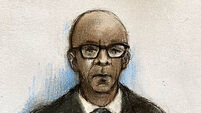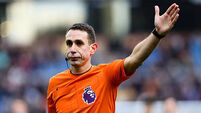Why we no longer see the full story

November 18, 1985. Joe Theismann, Washington Redskins quarterback, took a snap but hesitated, couldn’t find a receiver. Two New York Giants defenders closed in, then giant linebacker Lawrence Taylor crashed into Theismann from behind.
The QB didn’t get up, but it was Taylor’s panicked reaction that raised America’s alarm. He jumped up waving his hands frantically, screaming to the touchline for help.
The instinct of broadcaster ABC was to find out the story and show the audience. Commentator Frank Gifford invited viewers to “take a look on our reverse-angle camera.” America saw Theismann’s tibia and fibula snap and one of the bones come jutting through his skin. After a short commercial break, ABC zoomed in on Theismann’s bloodied leg then showed the incident again. “If your stomach is weak... just don’t watch,” Gifford advised.
Evidently, our collective stomachs are quite strong, because clips of the incident draw millions of views on YouTube. It is the yardstick by which gruesome injuries are measured.
Broadcasters’ instincts have changed everywhere since.
Last Friday night, we knew something bad had happened to Seamus Coleman when we weren’t seeing Neil Taylor’s tackle again. We have grown accustomed to the clarification — ‘we have decided not to bring you a replay of the challenge’.
Last Friday night, RTÉ’s match director Kevin O’Connell had to make the call. Head of Sport Ryle Nugent believes his man got it spot on.
“All the available angles were looked at. A decision was made and the right decision was made. We don’t have a written policy on it but we have a very clear understanding of what it is we’re trying to do.
“It’s a two-point decision; we have a responsibility to the audience and to the individual. The audience aren’t expecting to see something like that and it’s a general audience so you’ve got a lot of young kids watching. And secondly, it’s about the individual and their right to be protected to a level when they are in distress.
“Our directors, who are all, at this stage, very seasoned pros understand what it is that they’re supposed to do. And it has to be left to their discretion, because they are the ones that are living it, seeing it and dealing with it and literally having to make a call on it in seconds.”
RTÉ did include a replay of the tackle in its post- match analysis, though not one with a close-up of Coleman’s injury.
“You have to contextualise it. But you have the space to decide that. That 30 minutes or 15 minutes gives the editor the opportunity to see what’s available and what is appropriate in the circumstances.”
Nugent accepts it’s a tricky situation, even for experienced editors and directors. The journalist’s instinct is to tell the story. The same dilemma faced newspapers last weekend, with so many graphic photos available.
“We sat in a room over the weekend with the production teams and then spoke about it again on Monday and Tuesday and asked did we do the right thing. Did we handle that the way we should have? And the general consensus is we did.
“But equally the wrong decision could be made, and that has to be okay as well because it is a call in the moment.”
Head injuries are another challenge. RTÉ’s League Sunday programme showed Cillian O’Connor staggering to his feet in Omagh last weekend, appearing dazed. Were we invading his privacy?
“I think every single collision that produces a physical reaction that’s not expected falls into the category of ‘should we or shouldn’t we’,” Nugent says.
“I think if somebody gets a bang on the head, and it happens probably in rugby more than in most sports, that once it’s not a particularly distressed moment, but if it is indicative of ‘x is in trouble’, that’s reasonable.
“If someone then collapses, now you’ve got to take a decision to step back from it. You can show it from a wider angle rather than be in really tight on somebody’s face. You can tell the story without showing every element of the story.
“It’s not about us being a nanny state and protecting people, but there is a level where you say actually, that’s not appropriate for us to show at this moment in time. And you also have a responsibility to the individual who has been impacted and their family.”
Joe Theismann’s break ended his career. Twenty years later, he finally watched a clip with a reporter and explained what our intrusion took and gave.
“What the injury did for me, it basically became my identity. I’m basically the godfather of broken legs.”










